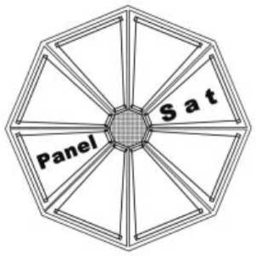PanelSat® SoSo-steering
(Switch on, Switch off)

© PanelSat GmbH

SOSO-steering (switch on, switch off)
SoSo-steering is the main and fuel free attitude control function of PanelSat®. It allows to point and turn the satellite about 9 axles. Its 8 panels, which are placed in 4 pairs on opposite sides of the spacecraft generate 4 main axles between each panel pair.
Two panel pairs which are placed side bei side, constitute 4 additional axles in between those main axles which are shifted 45° between them.
The 9. axis is caused by positioning panels windmill like, so that the spacecraft rotates about the center of the panel plane.
This allows to furnish each axis with different instrumentation, for instance on one axis regular camera equipment, on the other radar, on the other Lidar, on the other a transceiver ...., and by turning the pointing axis to the wished position the needed instrumentation is switched also.
Tilting sun-wards looking panels with their edge towards sun, switches the light pressure onto those panels off, while the partner panels in on position on the other side of the spacecraft continue to push on their side, so that the spacecraft is rotated about the concerned axles.
This results in a turn of the satellite body around the axle between those panels.
It is also possible to tilt 2, 3 or 4 panels at once to enhance the turning power and shorten the turning time of the spacecraft.
Changing attitude control to SoSo-steering enables the spacecraft operators to get rid of energy comsuming flywheels.
Experimental validation of SoSo-Steering — in vacuum, suspended on a thread
To verify the core principles of SoSo-Steering — the attitude control of a spacecraft using only selective solar radiation pressure (SRP) — a structured experimental sequence is proposed. All experiments are conducted in a vacuum chamber, where the PanelSat model is suspended from a single thread fixed at its center of mass. This setup allows free rotation without air resistance, simulating microgravity behavior in one axis.
Preliminary Experiment 1:
SRP on black surface
A simplified PanelSat model (without panels) is 3D printed from thermally stable, space-grade material (e.g. Ultem 1010).
One half of the model’s frontal surface is covered with black matte paper.
A collimated light source is directed at the model inside the vacuum chamber.
Hypothesis: The asymmetric photon pressure on the blackened side causes the model to rotate slowly.
This confirms that SRP can exert measurable torque under space-like conditions.
Preliminary Experiment 2:
SRP on reflective surface
The black paper is replaced with a highly reflective foil.
Under identical lighting, the model is expected to rotate more quickly, due to increased momentum transfer via photon reflection.
This confirms the scalability of SRP-induced torque with surface properties.
Main Experiment: Panel-based SoSo-Steering
A functional PanelSat model with tiltable panels is suspended in the same vacuum setup.
Two adjacent panels on one side are tilted edge-on toward the light source (SRP off), while the opposite pair remains fully exposed (SRP on).
This creates a directional imbalance in radiation pressure, causing the satellite to rotate around the thread axis.
This experiment serves as a direct validation of the SoSo-Steering principle.
Next development step: autonomous light tracking (not yet implemented)
A future goal is to enable the PanelSat demonstrator to autonomously follow a moving light source — e.g. mounted on a rotating arm inside the vacuum chamber.
For this, the onboard controller must evaluate the SRP imbalance in real time and adjust the panel orientations accordingly.
Once implemented, this would demonstrate fully passive and autonomous sun-tracking, a key functionality for future PanelSat missions.
This feature is not yet part of the current test setup, but defines the trajectory of ongoing development.
Datenschutz/data protection



